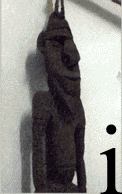
|
|
||
|
number of local artifacts. None of them are by any means important cultural artifacts Ė just mostly touristy type thingies. I like them nonetheless. The majority of commercial carvings in PNG originate either in the Sepik River Basin or the Papuan Gulf. Here in Madang, it is quite difficult to get away from Sepik carvings, as they are everywhere Ė in markets, in trade shows, even on the street. Papuan pieces are far and few between, and often far too costly for a mere volunteer like myself. This does not suggest that other PNG regions donít indulge in carving, but the majority of their carvings are solely for religious purposes and are often shrouded in secrecy, being shown only to initiated men of the particular village. For this reason, it is quite difficult (and I believe) corrupt to acquire such artifacts. Actually, PNG has had a sad history of watching its religious icons being removed from its soil. Apparently, there are private collections of PNG art in Australia which far outstrip the collection in the national museum. Iíve tried my best to find out where these carvings originated from and what they signified. Unfortunately, most of the sellers in Madang are not the carvers themselves, and know very little about the carvings themselves (besides their rather arbitrary price). To make things worse, I have not come across and good literature that could help me out. Accordingly, all the information I have on them is that they are from the Sepik region (although I suspect some are from the Ramu region) Yes, I know these names mean very little to you, but hey, they sound cool. † |



